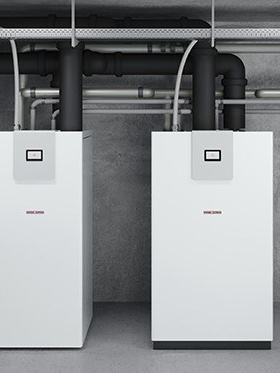
What is geothermal?
Geothermal heating and cooling, often referred to as ground source heat pumps, is a sustainable and renewable source of heating and cooling. Like other renewables (e.g., solar and wind), geothermal is an alternative to traditional fossil fuels and produces zero carbon emissions, making it an environmentally friendly option.
Accessing a geothermal source for temperature regulation involves a complex system that exchanges heat from the ground to the surface. The ground serves as a heat source or sink, with probes drilled up to 400m. This process is also known as shallow geothermal or geo-exchange.
Before we delve into how geothermal is utilized for heating and cooling, let’s first understand the key components of a geothermal system.
Key components of geothermal heating and cooling
A geothermal system comprises three main parts that facilitate heat transfer:
- Geothermal Collectors and Probes: These are a series of connected pipes installed beneath the building. They circulate a fluid, known as a brine solution, to exchange heat between the building and the earth’s stable temperature. Geothermal collectors are installed horizontally & probes can be installed vertically, depending on space availability and heating/cooling load requirements.
- A Heat Distribution System: This system circulates water from the heat pump throughout the building, either through conventional refrigerant systems or hydronic chilled water systems.
- Geothermal Heat Pumps (GHP): The heat pump is the core component that connects the geothermal ground loops to the heat distribution system. They transfer heat from the ground fluid and process it as heat into the building. Conversely, they can remove heat from the building and transfer it underground in summer.

What is Geothermal Heating?
This process uses a heat pump to extract heat from the earth and convert it into warm air for the building. Utilizing the ground’s constant temperature, the system exchanges it with the cooler air above.
The temperature underground is relatively stable, regardless of the temperature above ground. A geothermal system leverages the ground’s constant temperature and exchanges it with the cooler temperature above.
In a geothermal heating cycle, heat from the ground is moved through a fluid in the ground loops and into the heat pump. The fluid then undergoes a cycle of evaporation, compression, condensation, and expansion in the heat pump and its energy is released into the building.
In a cooling cycle, the heat pump intelligently works in reverse to move warmer air from the building and reject that heat into the earth.

What is Geothermal Cooling?
Conversely, the heat pump absorbs warm air from the building and transfers it underground, while distributing cooler water from the ground into the building. This cycle doesn’t generate cool air but transfers heat from the building, storing it underground for later use in heating.

Benefits of Geothermal Heating and Cooling
Geothermal heating and cooling are immensely beneficial for its users and the environment.
Here are some of the major benefits:
Reliability
Geothermal systems provide stable heating and cooling, independent of external conditions like sun and wind.
Clean energy
They operate without emitting carbon or toxic gases, offering a sustainable energy solution.
Silent operation
Geothermal heat pumps operate quietly, unlike traditional HVAC units.
Efficiency and maintenance
These systems are more than 70% energy-efficient than an air sourced system and require minimal maintenance once installed.
Hidden machines
The components are installed indoors or underground, maintaining the aesthetic of your property.
Pays for itself
Geothermal systems can significantly reduce energy bills, paying for themselves within 5-8 years.

What to consider when installing a Geothermal Heating and Cooling System
Installation requires space for drilling and may cause temporary noise and disruption, which is a small trade-up for the long-term benefits. Choosing a reputable installer like SóGeo ensures the longevity and efficiency of your geothermal system.
At SóGeo, we leverage our extensive experience in geothermal technology to provide top-notch installation services, using innovative and reliable products. If you’re considering transitioning to geothermal, our team is here to guide you every step of the way.
For more information on switching to geothermal, contact our team today.






